C5aR2 protein in neutrophils may drive inflammation in EBA
Mouse study links protein to disease progression in rare disorder

New study findings show how the complement system C5aR2 protein at the surface of neutrophils, a type of immune cell, may contribute to the progression of the rare autoimmune disease epidermolysis bullosa acquisita (EBA).
Mice lacking C5aR2 specifically at the surface of neutrophils had lessened inflammation.
“Signaling through C5a receptors induces a local inflammatory milieu [and] primes neutrophils for an inflammatory response,” the researchers wrote.
The study, “The complement receptor C5aR2 regulates neutrophil activation and function contributing to neutrophil-driven epidermolysis bullosa acquisita,” was published in the journal Frontiers in Immunology.
Disease progression eased in mice lacking C5aR2
In EBA, a type of epidermolysis bullosa, the body produces autoantibodies against the skin protein type VII collagen (COL7), a major component of the anchoring structures that hold the two top layers of the skin — called the dermis and epidermis — together.
These autoantibodies bind their targets at the junction between the skin layers, and activate the complement system, which is another part of the immune system that enhances the action of antibodies and specialized cells.
A past study showed that mice lacking the C5 component of the complement system across all the cells in the body were protected from experimentally induced EBA. Those findings supported the idea that C5 plays an important role in the development of the disease.
C5 promotes inflammation by triggering the recruitment and activation of immune cells that express its binding receptor proteins. One such receptor, called C5aR2, was shown to enhance the pro-inflammatory status in EBA. In mice lacking C5aR2, the symptoms of EBA were significantly milder.
Following lab tests suggesting that C5aR2 specifically in neutrophils could promote the sustained inflammation in EBA, researchers at the University of Lübeck, in Germany, now tested this hypothesis in mice.
The team genetically engineered a mouse model to lack C5aR2 specifically and only in neutrophils, and then induced EBA by injection of antibodies against type VII collagen. Mice submitted to the same manipulation but with C5aR2 intact were used as controls.
In line with their previous data, the researchers found that mice lacking C5aR2 in neutrophils showed easing of disease progression. This manifested as a significantly lower number of lesions, erosions, and blisters when compared with control mice with an intact C5aR2 expression in neutrophils.
The ability of bone marrow neutrophils to travel in response to C5a increase, a process known as chemotaxis, did not differ between the two groups; neither did neutrophil numbers.
Researchers: C5aR2 plays ‘critical role’ in regulating neutrophils
The scientists then tested whether bone marrow neutrophils in the two groups were similarly activated following stimulation with C5a. In addition, they also assessed the cell’s activation in normal (wild-type, WT) mice, with C5aR2 intact and not submitted to any manipulation. Activation was determined by measuring the levels of a surface protein called CD11b.
These results showed that the levels of CD11b in neutrophils lacking C5aR2 were significantly reduced when compared with neutrophils from the WT mice (mean 172.3% vs. 215.1%). However, they were not lessened in comparison with control mice (mean 190.3%), suggesting that a reduced stimulation with C5a could be partly the reason for the reduced disease progression seen in these animals.
The findings presented here confirm our previous hypothesis that C5aR2 plays a critical role in regulating neutrophil activation and function that contributes to neutrophil-driven autoimmune diseases such as EBA.
Levels of the Fc-gamma family of receptor proteins also were measured by the scientists. The levels of one member of this particular family, called Fc-gamma RIIb and known to suppress inflammation triggered by autoantibodies, were significantly increased in bone marrow neutrophils lacking C5aR2 compared with WT and control mice. The same was seen in blood neutrophils.
“Neutrophils lacking C5aR2 showed decreased activation after C5a stimulation and increased expression of the inhibitory [Fc-gamma] receptor [Fc-gamma] RIIb,” the researchers wrote.
Overall, “the findings presented here confirm our previous hypothesis that C5aR2 plays a critical role in regulating neutrophil activation and function that contributes to neutrophil-driven autoimmune diseases such as EBA,” the team concluded.
Researchers noted, however, that “further experiments are needed to fully understand the still enigmatic role of C5aR2 in the regulation of the neutrophil-driven immune response.”








